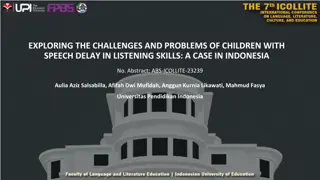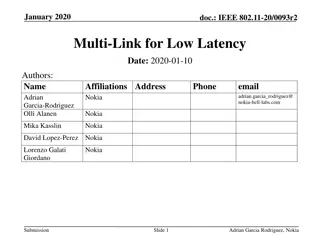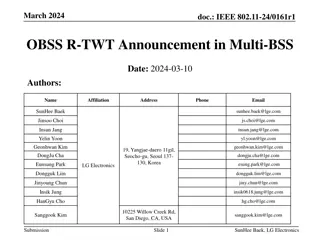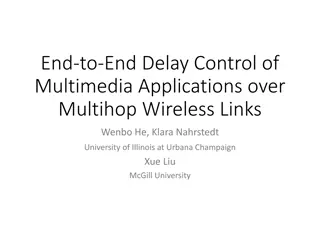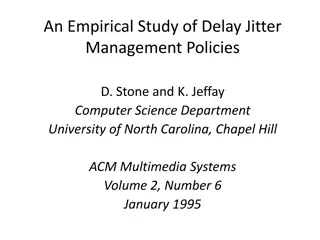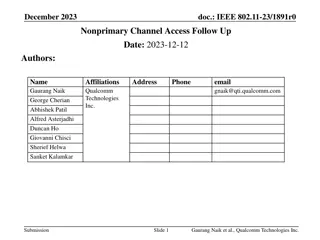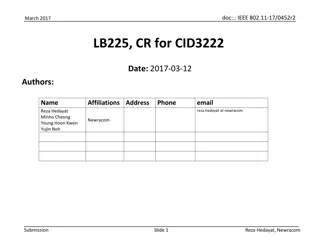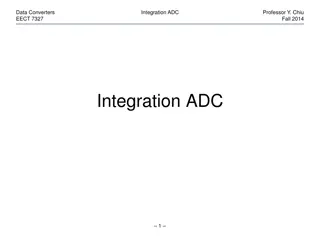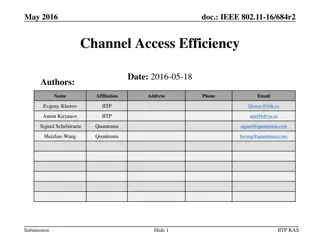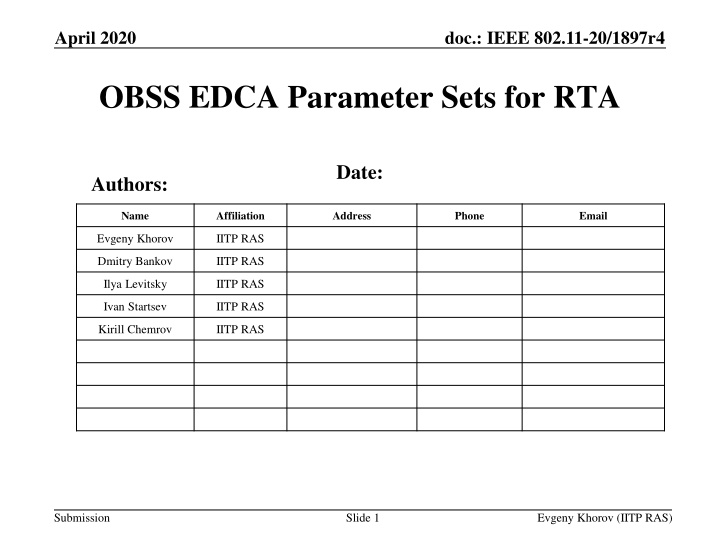
Reduction of Channel Access Delay in OBSS through EDCA Parameter Optimization
This presentation discusses a method to minimize channel access delay in scenarios with overlapping basic service sets (OBSS) by adjusting and synchronizing EDCA parameters among neighboring access points. It explores the impact of CSMA/CA and legacy devices on real-time applications, proposing solutions to meet RTA requirements efficiently.
Download Presentation

Please find below an Image/Link to download the presentation.
The content on the website is provided AS IS for your information and personal use only. It may not be sold, licensed, or shared on other websites without obtaining consent from the author. If you encounter any issues during the download, it is possible that the publisher has removed the file from their server.
You are allowed to download the files provided on this website for personal or commercial use, subject to the condition that they are used lawfully. All files are the property of their respective owners.
The content on the website is provided AS IS for your information and personal use only. It may not be sold, licensed, or shared on other websites without obtaining consent from the author.
E N D
Presentation Transcript
April 2020 doc.: IEEE 802.11-20/1897r4 OBSS EDCA Parameter Sets for RTA Date: Authors: Name Affiliation Address Phone Email Evgeny Khorov IITP RAS Dmitry Bankov IITP RAS Ilya Levitsky IITP RAS Ivan Startsev IITP RAS Kirill Chemrov IITP RAS Submission Slide 1 Evgeny Khorov (IITP RAS)
April 2020 doc.: IEEE 802.11-20/1897r4 Abstract The ability of 11be devices to support RTA depends not only on the mechanisms implemented in these devices but also on the how other devices access the channel. This presentation proposes and evaluates a method to reduce channel access delay in case of OBSS by tuning and synchronizing EDCA parameters at neighboring APs. Submission Slide 2 Evgeny Khorov (IITP RAS)
April 2020 doc.: IEEE 802.11-20/1897r4 Outline Use case Single BSS Scenario Problem of RTA Caused by CSMA/CA Performance Evaluation OBSS Scenario Problem of RTA Caused by OBSS Performance Evaluation, OBSS Scenario Proposal Submission Slide 3 Evgeny Khorov (IITP RAS)
April 2020 doc.: IEEE 802.11-20/1897r4 Thoughts on RTA Wi-Fi is based on CSMA/CA Even modern OFDMA works upon CSMA/CA (OFDMA transmission/TF can be sent only if the AP accesses the channel according to EDCA) Wi-Fi is full of legacy devices A user may upgrade all his/her APs, but it is hardly possible to quickly upgrade all the devices connected to these APs 802.11be may include new channel access methods, but a typical 802.11 network consists of devices of various generation, including those not supporting new features. We need to satisfy RTA requirements in the presence of legacy devices transmitting heavy delay-tolerant flows. Submission Slide 4 Evgeny Khorov (IITP RAS)
April 2020 doc.: IEEE 802.11-20/1897r4 Use cases Large houses Multiple APs cover the house area. From time to time the RTA service is needed. User can configure the APs in a static way. The APs may contain some sophisticated algorithms but the APs work independently from each other No interference from other networks VR/AR clubs Large area isolated from external radio, need RTA support for wireless VR headsets. Submission 5 Evgeny Khorov (IITP RAS)
April 2020 doc.: IEEE 802.11-20/1897r4 Problem of RTA Caused by CSMA/CA If a STA generates an RTA frame but the channel is occupied, it has to wait until the channel becomes idle. After that, the STA has to win the contention for channel Total delay RTA frame generation Backoff AIFS SIFS Other STA s transmission RTA frame Ack t Frame transmission Channel access delay Total delay = Channel access delay + Frame transmission Channel access delay = Ongoing transmission duration + AIFS + Backoff Ongoing transmission duration is limited by TXOP limit. Backoff: To make sure that an RTA STA does not contend with non-RTA STAs, it is necessary to set AIFSNRTA + CWmaxRTA < AIFSNnon-RTA (holds for every non-RTA AC) By tuning these EDCA parameters, we can reduce channel access delay. Submission 6 Evgeny Khorov (IITP RAS)
April 2020 doc.: IEEE 802.11-20/1897r4 Remark about TXOP limits According to 10.23.2.9 TXOP limits, by setting a small and non-zero TXOP limit, we can limit the duration of almost all frames Submission 7 Evgeny Khorov (IITP RAS)
April 2020 doc.: IEEE 802.11-20/1897r4 Tuning EDCA parameters improves RTA in a single BSS Scenario Scenario description: 1 10 RTA STAs, each of which generates an RTA packet with a period of 20 ms 10 non-RTA STAs generate saturated traffic All STAs are in the TX range of each other Transmissions of RTA STAs last 0.5 ms (incl. DATA+SIFS+ACK) Transmissions of non-RTA STAs are limited by the TXOP limit Submission 8 Evgeny Khorov (IITP RAS)
April 2020 doc.: IEEE 802.11-20/1897r4 EDCA Parameters, 1 BSS Scenario Default EDCA Parameters Tuned EDCA Parameters RTA (AC_VO) Non-RTA (AC_BE) RTA Non-RTA AIFSN 2 3 2 10 CWmin 3 15 7 15 CWmax 7 1023 7 1023 {0.5, 1, 2, 2.5}ms TXOP Limit 2.528 ms 2.528 ms 2.528 ms But RTA TX = 0.5 ms But RTA TX=0.5 ms AIFSNnon-RTA = AIFSNRTA + CWRTA +1 Changed from 3 to 7 to reduce contention Submission 9 Evgeny Khorov (IITP RAS)
April 2020 doc.: IEEE 802.11-20/1897r4 Performance Evaluation, Delay With Tuned EDCA, we can satisfy RTA requirements, e.g., provide delay less than 10 ms with a high probability Average delay 99.9% percentile of delay On the contrary, standard EDCA provides ~2 times higher average delay and much higher delay percentile Submission 10 Evgeny Khorov (IITP RAS)
April 2020 doc.: IEEE 802.11-20/1897r4 Delay distribution for 5 RTA STAs Probability that the delay restriction is violated Delay, ms Submission 11 Evgeny Khorov (IITP RAS)
April 2020 doc.: IEEE 802.11-20/1897r4 Channel Usage Efficiency Channel usage efficiency is measured as the portion of channel time occupied by payloads of successful data transmission by RTA and non-RTA STAs The cost for providing low-delay channel access is up to 25% reduction of the channel usage efficiency. So it should be activated only when there is RTA traffic. The static configuration of EDCA Parameters is not efficient. The efficiency of Default EDCA is higher because the AIFSN and TXOP limit parameters of non-RTA traffic are lower than in case of Tuned EDCA EDCA Parameter Set can be used to dynamically configure EDCA parameters for one BSS Submission 12 Evgeny Khorov (IITP RAS)
April 2020 doc.: IEEE 802.11-20/1897r4 Problem of RTA Caused by OBSS In case of OBSS, the AP cannot control EDCA parameters at neighboring APs. We need a mechanism to coordinate TXOP limits and AIFSN in OBSS. We propose a method that allows neighboring APs to synchronize their EDCA parameters in order to satisfy the RTA requirements. The APs that support this and other TBD features are referred to as RTA-friendly. If all APs in OBSS are RTA-friendly, we obtain an RTA-friendly environment. NOTE: To support RTA, we need the absence of RTA non-friendly APs (that allow transmitting heavy flows with minimal AIFSN and CWmin) or extremely low traffic in such BSSs Submission 13 Evgeny Khorov (IITP RAS)
April 2020 doc.: IEEE 802.11-20/1897r4 OBSS Scenario Non-RTA STA BSS1 BSS2 RTA STA Transmission range of each other 2 BSS operate in the same area BSS1 (RTA-friendly) N RTA and 5 non-RTA STAs EDCA Parameters are tuned. TXOP limit is shown in the legend BSS2 (2 cases: RTA-friendly or non-RTA-friendly) 5 non-RTA STAs EDCA Parameters are tuned only if BSS2 is RTA-friendly Submission Slide 14 Evgeny Khorov (IITP RAS)
April 2020 doc.: IEEE 802.11-20/1897r4 Performance Evaluation, Delay Average delay 99.9% percentile of delay Caused by tuning EDCA at neighboring APs Legacy STAs have default AC_BE parameters and their transmissions can collide with RTA STAs transmissions With legacy OBSS operation, delays are even a bit higher than without tuning EDCA Parameters in own BSS (see slide 10). Submission 15 Evgeny Khorov (IITP RAS)
April 2020 doc.: IEEE 802.11-20/1897r4 Proposal An RTA-friendly AP can ask the neighboring RTA-friendly APs - to limit the maximal TXOP Limit of all ACs - to limit the minimal AIFSN[AC] for all non-RTA ACs - Other EDCA parameters TBD. For that, the AP that has RTA traffic, indicates in its beacons (or other frames) the requested maximal TXOP Limit and minimal AIFSN for neighboring APs during the time, when and if such limitations are needed. The neighboring RTA-friendly APs need to receive such a request in the beacon and they shall modify the EDCA parameter set and MU EDCA Parameter set for their BSSs to satisfy the limits. Note: only the AP-AP interaction is proposed. AP-STA interaction works as is. Note: In case of AP MLDs, the proposed operation works independently on each link. Submission 16 Evgeny Khorov (IITP RAS)
April 2020 doc.: IEEE 802.11-20/1897r4 Container for the Requested Parameters. Option 1 Use the existing EDCA Parameter Set element but add a 1-bit field called RTA EDCA Parameters Request to specify that the AP requests the neighboring APs to tune their EDCA parameters according to the limits calculated from the EDCA Parameter Set of the requesting AP Requested TXOP Limit = maximal TXOP limit of the EDCA Parameter set Minimal AIFSN = minimal AIFSN of non-RTA ACs limit of the EDCA Parameter set The request is valid during some preassigned value, e.g., a beacon interval or a DTIM interval Pros: small overhead Cons: in case of multiple OBSS with RTA traffic, all APs are tuned according to the strongest limitations (see next slide) Submission Slide 17 Evgeny Khorov (IITP RAS)
April 2020 doc.: IEEE 802.11-20/1897r4 Container for the Requested Parameters. Option 1 (cont.) In case of multiple OBSS with RTA traffic, all APs are tuned according to the strongest limitations. Consider multiple BSSs of RTA-friendly APs as shown below. All APs sense beacons of the neighboring APs. AP1, AP2 and AP3 have RTA traffic and set up the RTA EDCA Parameters Request bit AP2 AP1 AP3 Requests AIFSNnon-RTA=10 Requests AIFSNnon-RTA=15 Requests AIFSNnon-RTA=5 Submission Slide 18 Evgeny Khorov (IITP RAS)
April 2020 doc.: IEEE 802.11-20/1897r4 Container for the Requested Parameters. Option 1 (cont.) In case of multiple OBSS with RTA traffic, all APs are tuned according to the strongest limitations Consider multiple BSSs of RTA-friendly APs as shown below. All APs sense beacons of the neighboring APs. AP1, AP2 and AP3 have RTA traffic and set up the RTA EDCA Parameters Request bit AP2 AP1 AP3 Requests AIFSNnon-RTA=10 Requests AIFSNnon-RTA=15 Requests AIFSNnon-RTA=5 Beacon AIFSNnon-RTA =15 AP1 AIFSN=10 AIFSNnon-RTA=15 AIFSN=10 AP2 All use AIFSNnon-RTA =15 AP3 AIFSN=15 Submission Slide 19 Evgeny Khorov (IITP RAS)
April 2020 doc.: IEEE 802.11-20/1897r4 Container for the Requested Parameters. Option 2 A candidate container is an RTA EDCA Information Element with the fields Requested TXOP Limit ( 2 octets) Minimal AIFSN (1 octet) Validity (1 octet) measured in beacon intervals Other fields TBD Such IE should be included in all beacons while the restriction is needed. Pros: Better flexibility, explicit notification fixes the problem from previous slide Cons: Need to design an additional element Submission Slide 20 Evgeny Khorov (IITP RAS)
April 2020 doc.: IEEE 802.11-20/1897r4 Conclusion Configuration of TXOP limit and AIFSN for RTA and non- RTA transmissions can provide delay less than 10 ms with reliability higher than 99.999% In OBSS scenarios, we need to sync EDCA Parameters at neighboring APs. A method to sync EDCA Parameters is proposed and evaluated. Submission 21 Evgeny Khorov (IITP RAS)
April 2020 doc.: IEEE 802.11-20/1897r4 SP 1 Do you support to define a method intended to limit the values in the EDCA parameters set and MU EDCA Parameter set at neighboring APs? Submission Slide 22 Evgeny Khorov (IITP RAS)
April 2020 doc.: IEEE 802.11-20/1897r4 SP 2 Do you support to define an RTA-friendly AP that shall follow specific channel access rules to support RTA, regardless of the presence of RTA traffic. Note: The exact name for RTA-friendly AP is TBD Note: The exact channel access rules are TBD (e.g., tuning EDCA parameters) Submission Slide 23 Evgeny Khorov (IITP RAS)
April 2020 doc.: IEEE 802.11-20/1897r4 SP 3 Do you support that an 11be AP can declare itself as RTA friendly by setting an RTA-friendly flag in its EHT capability information element? Submission Slide 24 Evgeny Khorov (IITP RAS)
April 2020 doc.: IEEE 802.11-20/1897r4 SP 4 Which option do you prefer as the container for requesting EDCA parameters in beacons: Option 1 (RTA EDCA Parameters Request Bit) Option 2 (RTA EDCA Parameter Set Information Element) Both Neither Need more info Abstain Note: Exact names are TBD Exact location of RTA EDCA Parameters Request Bit is TBD Submission Slide 25 Evgeny Khorov (IITP RAS)
April 2021 doc.: IEEE 802.11-20/1897r4 Backup slides Submission Slide 26 Evgeny Khorov (IITP RAS)
April 2021 doc.: IEEE 802.11-20/1897r4 Fig. 2. Percentage of channel time occupied by successful TX of non-RTA STAs in the Single BSS Scenario Submission Slide 27 Evgeny Khorov (IITP RAS)


